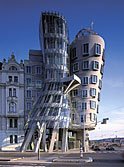Hal Foster on Frank Gehry
 I'm watching a PBS documentary on Frank Gehry right now. As frequent readers know, I'm not fond of a lot of Gehry's buildings. As I'm watching this, I'm seeing some stuff I can appreciate. I think some of his lesser known buildings -- the Fred and Ginger building in Prague (pictured) comes to mind -- are brilliant. But, watching this documentary, I also found a critic who articulates some of my frustration with Gehry: Princeton University's professor of art and archeaology, Hal Foster.
I'm watching a PBS documentary on Frank Gehry right now. As frequent readers know, I'm not fond of a lot of Gehry's buildings. As I'm watching this, I'm seeing some stuff I can appreciate. I think some of his lesser known buildings -- the Fred and Ginger building in Prague (pictured) comes to mind -- are brilliant. But, watching this documentary, I also found a critic who articulates some of my frustration with Gehry: Princeton University's professor of art and archeaology, Hal Foster.  Here are some choice passages from his review, called "Why all the hoopla?", of a 500 page coffee table book about Gehry (a modified version of which appears in his book Design and Crime):
Here are some choice passages from his review, called "Why all the hoopla?", of a 500 page coffee table book about Gehry (a modified version of which appears in his book Design and Crime):"The great irony is that Gehry fans tend to confuse his arbitrariness with freedom, and his self-indulgence with expression."I like that one a lot. What Foster said on the PBS documentary is that people need to look at Gehry's work critically. Negative criticism serves to combat the "culture of affirmation" around superstars like Gehry. Artist Julian Schnabel called Gehry's detractors "flies around the neck of a lion." I find that odd; it sounds more like the sort of thing conservatives say about left-wing criticism of our president.
I liked What Foster said about Seattle's Experience Music Project (EMP), because I struggled to say something very similar:
The disconnection between skin and structure represented by this academic model is at its most radical in Gehry's work in the Experience Music Project, commissioned by the Microsoft billionaire Paul Allen because of his love for Jimi Hendrix (a fellow Seattleite): its six exterior blobs clad in different coloured metals have little apparent relation to its many interior displays dedicated to pop music. Just as Gehry wanted to make Bilbao legible through an allusion to a splintered ship, here he makes an allusion to a smashed guitar (a broken 'fret' lies over two of the blobs). But neither image works, even as a Pop gesture, for you have to be well above the buildings to read them as images at all, or you have to see them in media reproduction - which is indeed a primary 'site' of this architecture.I was uncomfortable with the EMP, partly because it made little reference to its collection, but also because it overshadowed the meager collection. Foster takes the idea of Gehry as architect/sculptor and says it isn't necessarily such a good thing in its realization:
Like many other new museums, his colossal spaces are designed to accommodate the expanded field of postwar art - of Andre, Serra, Oldenburg, and assorted descendants. In fact, these museums trump the art: they use its great scale, which was meant to challenge the museum, as a pretext to inflate the museum itself into a gigantic spectacle-space that can swallow any art, let alone any viewer, whole. In short, museums like Bilbao use the breaking-out of postwar art as a licence to corral it again, and to overwhelm the viewer as they do so.Foster's conclusion makes Gehry sound like a Walmart-friendly tool of the capitalist superstate:
With Gehry and other architects the reverse is now true as well: spectacle is an image accumulated to such a degree that it becomes capital. Such is the logic of many cultural centres today, designed, alongside theme parks and sports complexes, to assist in the corporate 'revival' of the city - its being made safe for shopping, spectating and spacing out. 'The singular economic and cultural impact felt in the wake of its opening in October 1997,' the catalogue says of 'the Bilbao effect', has 'spawned a fierce demand for similar feats by contemporary architects worldwide'. Alas, so it has, and it is likely to come to your hometown soon.


0 Comments:
Post a Comment
<< Home